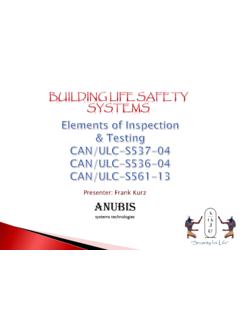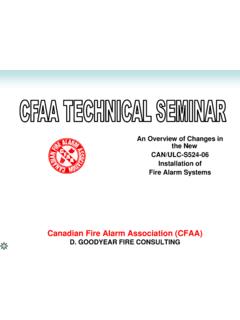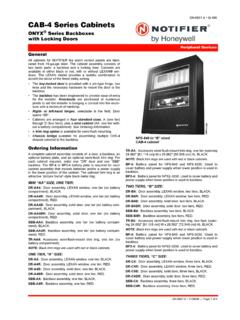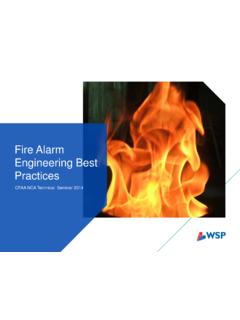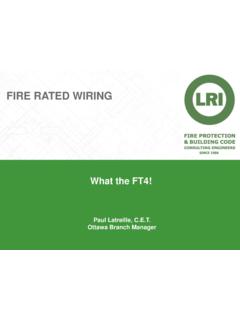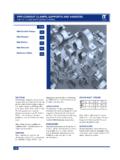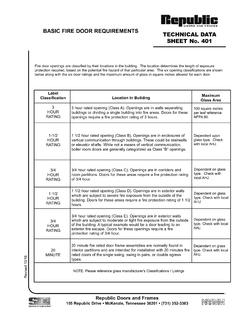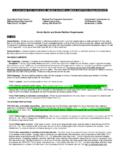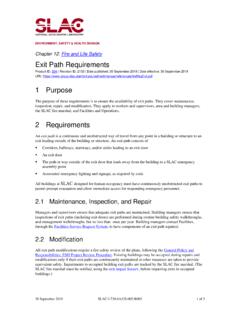Transcription of DOOR HARDWARE & BRITISH COLUMBIA BUILDING and …
1 DOOR HARDWARE & BRITISH COLUMBIA BUILDING and fire Bit of Objective Based Code of fire and Life OF CODE DEVELOPMENT Model Codes: National BUILDING Code (NBC) National fire Code (NFC) Written by Canadian Commission on BUILDING and fire Codes (CCBFC) Published by National Research Council First NBC: 1941 First NFC: 1965 HISTORY OF CODE DEVELOPMENT Codes are re-issued approximately every five years Code cycle: Anyone can submit a proposal to change a code requirement Reviewed by CCBFC Issued for public comment (anyone can comment) Voted on by CCBFC Adopted or rejected New code issuedHISTORY OF CODE DEVELOPMENT CCBFC Members from across the country Includes: BUILDING and fire Officials Consultants Contractors Manufacturers Matrix representation from various interest groups from all regionsNBC/NFC RELATIONSHIP Companion Documents BUILDING Code applies to new construction fire Code applies to existing construction, fire prevention, and maintenance & testing Same numbering system as National BUILDING Code (NBC) NFC has some requirements that must be built in PROVINCIAL CODES Each Province uses model codes to issue their own code We use.
2 BC BUILDING Code (BCBC) BC fire Code (BCFC) Provincial Codes become law by passing of Provincial Legislation Provincial Codes usually make changes to suit construction environmentPROVINCIAL CODES For the first time, there was a concerted coordination effort between CCBFC and Provinces when developing the 2005 codes Result is minimal changes from the model codes Biggest changes in BC are: Mezzanines Barrier Free AccessibilityVANCOUVER BUILDING BY-LAW Arises from Vancouver Charter Modeled on BCBC Some changes: Environmental Issues Green Buildings Secondary Suites SprinklersJURISDICTIONS 2007 VBBL/VFBL City of Vancouver only Effective May 1, 2007 2010 NBC/NFC Federal Lands in BC First Nations, Transport Canada 2012 BCBC/BCFC Everywhere else in BC Effective December 20, 2012 THE OBJECTIVEBASED FORMATBUILDING CODE NOW SPLIT INTO 3 DIVISIONS: Division A Compliance, Objectives and FunctionalStatements Division B Acceptable Solutions Division C Administrative DIVISION A - Almost all new DIVISION B - Old Code with changes DIVISION C - Old Part 2 HOW TO COMPLY WITH THE CODE:1.
3 Meet literal provisions of Division B,OR1. Use an alternative solution that meets the objectives and functional statements of Division A. Compliance Alternative 2 is what we used to know as equivalencies . Entire BUILDING does not necessarily have to comply with Division A PART 1:COMPLIANCE Includes definitions PART 2:OBJECTIVES PART 3:FUNCTIONAL STATEMENTSDIVISION B 9 PARTS Similar to old 1998 Code PART 1 Reference documents, climatic data PART 2 Reserved (Not used) PART 3 9 Same as 1998 Code, now with revisionsDIVISION C 2 PARTS PART 1:ABBREVIATIONS PART 2:ADMINISTRATION Details of drawings Documentation of alternative solutionsDIVISION A APPLICATION OF DIVISION A, B AND C: Division A + C:Applies to ALLbuildings. Division B:Same as 1995 1, 7, 8:- All buildingsPart 9:- 600 m2- 3 storeys- C, D, E, F2, F3 Parts 3, 4, 5, 6:- A, B, F1 All big buildingsCODE CONCEPTS KEY PHRASES: Limit the probability can t completely eliminate undesirable situations.
4 ( fire ) Unacceptable risk - NBC can t completely eliminate a BUILDING risk. Acceptable risk is what results from code CONCEPTS OBJECTIVES: Broad goals of Code. Defines undesirable situations and their consequences that the Code aims to avoid. Qualitative statements. Every code requirement must address at least 1 objective. Can t be used on their CONCEPTS OBJECTIVES: Safety ( Guards and handrails) Health ( Washrooms, air quality) Accessibility ( Paths of travel) fire and structural protection ( Ratings)CODE CONCEPTS FUNCTIONAL STATEMENTS: More level of detail. Interconnected with objectives. Can t be used on their own. Can be multiple functional statements for a single objective. Describe conditions in a BUILDING that help satisfy an APPLICATION STATEMENTS: Describes what each Division B requirement applies to.
5 Highest level of detail. Technically, not part of Code. Available only on ADIVISION A 3 STATEMENTSDIVISION A PART 1: COMPLIANCE (1) Compliance with this Code shall be achieved bya)complying with the applicable acceptable solutions in Division B (see Appendix A), orb)using alternative solutions that will achieve at least the minimum level of performance required by Division B in the areas defined by the objectives and functional statements attributed to the applicable acceptable solutions (see Appendix A). Key Sentence that links Division A and Division A COMPLIANCE WITH THE CODE If you meet Division B, no need to use Division A. Compliance with Division B is what we used to do under the older Codes. Division A compliance is used to be considered an equivalency , now an alternative solution.
6 For an alternative solution, must demonstrate that you have met objectives and functional statements. Each [most] requirement of Division B is assigned which objectives and functional statements are applicable (Tables).DIVISION A COMPLIANCE WITH THE CODE Alternatives have to meet all applicable objectives and functional statements. Must demonstrate as good as , not well enough . For complex solutions, may need to model a code compliant solution to compare. Intent Statements and Application Statements used to define the applicability of a Division B requirement. Will clarify acceptable level of risk .DIVISION A PART 2: OBJECTIVES SAFETY (OS) HEALTH (OH) ACCESSIBILITY (OA) fire + STRUCTURAL PROTECTION (OP)DIVISION A OSSAFETY An objective of this Code is to limit the probability that, as a result of the design, construction or demolition of the BUILDING , a person in or adjacent to the buildingwill be exposed to an unacceptable risk of injury.
7 Wording typical for all objectives. Limit the probability and unacceptable risk . Addresses acceptable risks to safety of the occupants (a person). 5 Categories:OS1 SEPARATIONS Definition: a construction assembly that acts as a barrier against the spread of fire Standard ULC S101 Standard time temperature curve Test representative sample in a furnace Assigned time is time to failure Basic Construction Features: Continuity Must have dampers (label) Need self closing devices Need latches Hold open devices Okay in some circumstances ( ) Release on 1ststage alarm Signage is good Don t prop doors openFIRE SEPARATIONSFIRE SEPARATIONSMAINTENANCE Maintain all elements in good working condition (BCFC) Fix holes Maintain doors and signs Requires diligence Don t replace wired glass with clear glass, Lexan not ratedSERVICE PENETRATIONS Pipes Ducts Conduit Exposed CablesPIPES No limits on size of steel or copper pipes Restrictions on Plastic Pipe but no limit on sizesDUCTS Need fire dampers in separations Welded steel required for kitchen grease ducts (NFPA 96)
8 SERVICE PENETRATIONSCONDUIT No restrictions on metallic conduit Plastic conduit 625 mm2max (1 diameter) FT4 labeled Okay if buried in concreteEXPOSED COMMUNICATION WIRING FT4 & CMP Max 1 diameter bundle sizeSERVICE PENETRATIONSFIRE STOPPING Use of listed assemblies Specific to product, penetrating items 2012 BCBC -cast in place or tightly fitting Test to CAN/ULC S115, not ASTM Ratings: fire SeparationFire Stop0 hour0 hour3/4hour3/4hour1 hour3/4hour1 1/2hour1 hour2 hours1 1/2hourFIRE STOPPING Rating Classes: F fire T Temperature rise on unexposed side H Hose station test at F time L Tested under simulated pressure difference acrossassemblyFIRE STOPPINGFIRE STOPPING Empty holes not supposed to just fill with mortar (falls out in fire ) Existing cable trays set fire stop systems ineffective need replaceable systems easier to maintain Diligence required by all to maintain fire separationsFIRE STOPPINGFIRE STOPPINGEXITINGBASIC CONCEPTS Exit.
9 Rated enclosure No services, no storage Must always be accessible Access to Exit nearly everything else Travel Distance path of travel to an exit Exit Capacity minimum width required to get everyone out in a reasonable period of timeEXIT STAIRS/ENCLOSURES Exits are treated as sacred in code No storage No services Max 25 flame spread rating Illuminated signageDOORS & DOOR HARDWARE Required ratings ( fire protection rating) fire SeparationDoor Rating3/4hour3/4hour1 hour3/4hour1 1/2hour1 hour2 hours1 1/2hour Must be self closing and positive latching in fire separations to overcome buoyant forces Lever sets are standard (no knobs) Panic sets required on all exit doors Must have single handed, single action release Needs mortise sets for deadbolts No storage function deadbolts Releasable without keys or specialized knowledge (question of request to exit button being specialized knowledge) doors & DOOR HARDWAREDOORS & DOOR HARDWAREDOORS & DOOR HARDWAREMAGLOCKS BCBC (4).
10 fire alarmrelease (2ndstage) Power loss release Remote release by manual switch 15 second release upon actuation of door HARDWARE Manual reset after release (excludes authorized bypass) Sign requirement on door Can have request to exit buttons, but not as the only way of releasing door Maglocks with 0 second delay are still subject to code requirements for maglocksMAGLOCKS Maglocks cannot incorporate latches or pins Electric strikes preferred never impede passage in direction of travel Public vs. Staff no differences in code application Cannot be used to arbitrarily lock down doors Attempt to restrict access results in non-compliant restrictions to egress routesELECTRIC STRIKES Can be used in combination with card reader Must fail closed to ensure positive latching when in fire separation Preferred over maglocks because they never restrict egress, but achieve security into a room or spaceSPECIAL CASES Contained Use and Impeded Egress Zones (hospitals, jails) Can have maglocks without fire alarm release Required operation by key switch accessible to authorized personnelSERVICES IN EXITS No openings except for exit doors (dampered ventilation openings) Permitted services.
